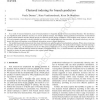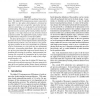SIGMETRICS
2011
ACM
13 years 9 months ago
2011
ACM
Branch taken rate and transition rate have been proposed as metrics to characterize the branch predictability. However, these two metrics may misclassify branches with regular his...
MAM
2007
14 years 6 months ago
2007
ct 8 As a result of resource limitations, state in branch predictors is frequently shared between uncorrelated branches. This interference 9 can significantly limit prediction acc...
JSA
2006
14 years 6 months ago
2006
In 2001, Jime
ARCS
2008
Springer
14 years 8 months ago
2008
Springer
Predictors essentially predicts the most recent events based on the record of past events, history. It is obvious that prediction performance largely relies on regularity
ISCA
1998
IEEE
14 years 10 months ago
1998
IEEE
Pipeline flushes due to branch mispredictions is one of the most serious problems facing the designer of a deeply pipelined, superscalar processor. Many branch predictors have bee...
IEEEPACT
1998
IEEE
14 years 10 months ago
1998
IEEE
Hybrid branch predictors combine the predictions of multiple single-level or two-level branch predictors. The prediction-combining hardware -- the "meta-predictor" -may ...
MICRO
1999
IEEE
14 years 10 months ago
1999
IEEE
Branch predictors typically use combinations of branch PC bits and branch histories to make predictions. Recent improvements in branch predictors have come from reducing the effec...
ISCA
2002
IEEE
14 years 11 months ago
2002
IEEE
This paper presents the Alpha EV8 conditional branch predictor. The Alpha EV8 microprocessor project, canceled in June 2001 in a late phase of development, envisioned an aggressiv...
RTAS
2003
IEEE
14 years 11 months ago
2003
IEEE
This paper investigates how dynamic branch prediction in a microprocessor affects the predictability of execution time for software running on that processor. By means of experim...
ISLPED
2004
ACM
14 years 11 months ago
2004
ACM
Designers have invested much effort in developing accurate branch predictors with short learning periods. Such techniques rely on exploiting complex and relatively large structure...


